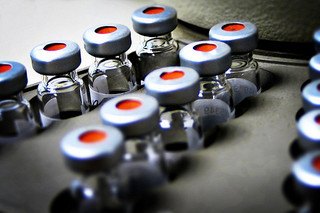

Chemical analysis is being performed on the urine of autistic children. Will vaccine ingredients be considered?
That’s a question on the minds of researchers at the University of Buffalo for several years now. UofB chemist Troy Wood and his team have been working on finding molecular compounds in autistic children’s urine. Troy is hopeful those compounds could become biological markers in tests to diagnose autism at earlier ages that definitely would be more objective and effective than current diagnostic procedures. Basically, he and his research team are looking for chemical clues. Personally, I’d love to be in that laboratory checking out spectrographic readouts.
One research team member, Charmion Cruickshank, found depleted levels of a reduced form of glutathione, which is an amino acid that, coincidentally, holistic or complementary and alternative medicine (CAM) uses in treating autistic children.
Glutathione is one of the network antioxidants extremely important in detoxifying and healing. Antioxidants strengthen the immune system by providing free radical intervention and protection. Interesting? Cruickshank also found that stercobilin, “A brown degradation product of hemoglobin present in feces” [1] also seemed abnormally low. Stercobilin is part of the heme breakdown that helps color human fecal matter. I wonder if that finding will lead to a fallback on the work of medical doctors who have found intestinal (gut) problems are common in autistic children.
The research team says their findings are indicative of oxidative stress. Of course, oxidative stress occurs from neurotoxins and other toxic materials in food, water, air, the environment, and vaccines, let’s not forget—something vaccinology apparently does not want to admit.
What researchers also ought to be looking for, I think—and so do others in holistic medical research—are quantitative amounts of selenium, the mineral precursor to glutathione, similar in biochemistry to what zinc is to the production of insulin, often referred to as metalloenzymes, “An enzyme having a metal, usually an ion, linked to its protein component.” [2] Selenium and glutathione are effective detoxifiers, especially for children who have been vaccinated with mercury [Thimerosal] and aluminum-containing vaccines.
Other chemical markers I think the UofB researchers ought to be tracking in autistic children’s urine are formaldehyde and Formalin. The body does not produce massive amounts of formaldehyde and certainly does not produce any Formalin. Both chemicals are used as manufacturing ingredients in many childhood vaccines.
I’m anxious to see where this research leads. The science behind it—if not messed with by vested interests—could be what is needed for a scientific determination and medical diagnosis of children on the autism spectrum disorder.
Resource
Charlotte Hsu, Hunting for autism’s chemical clues, University of Buffalo Reporter, July 5, 2012, http://www.buffalo.edu/ubreporter/2012_07_05/autism_biomarkers
References
[1] http://dictionary.reference.com/browse/stercobilin [2] http://dictionary.reference.com/browse/metalloenzyme?s=t
